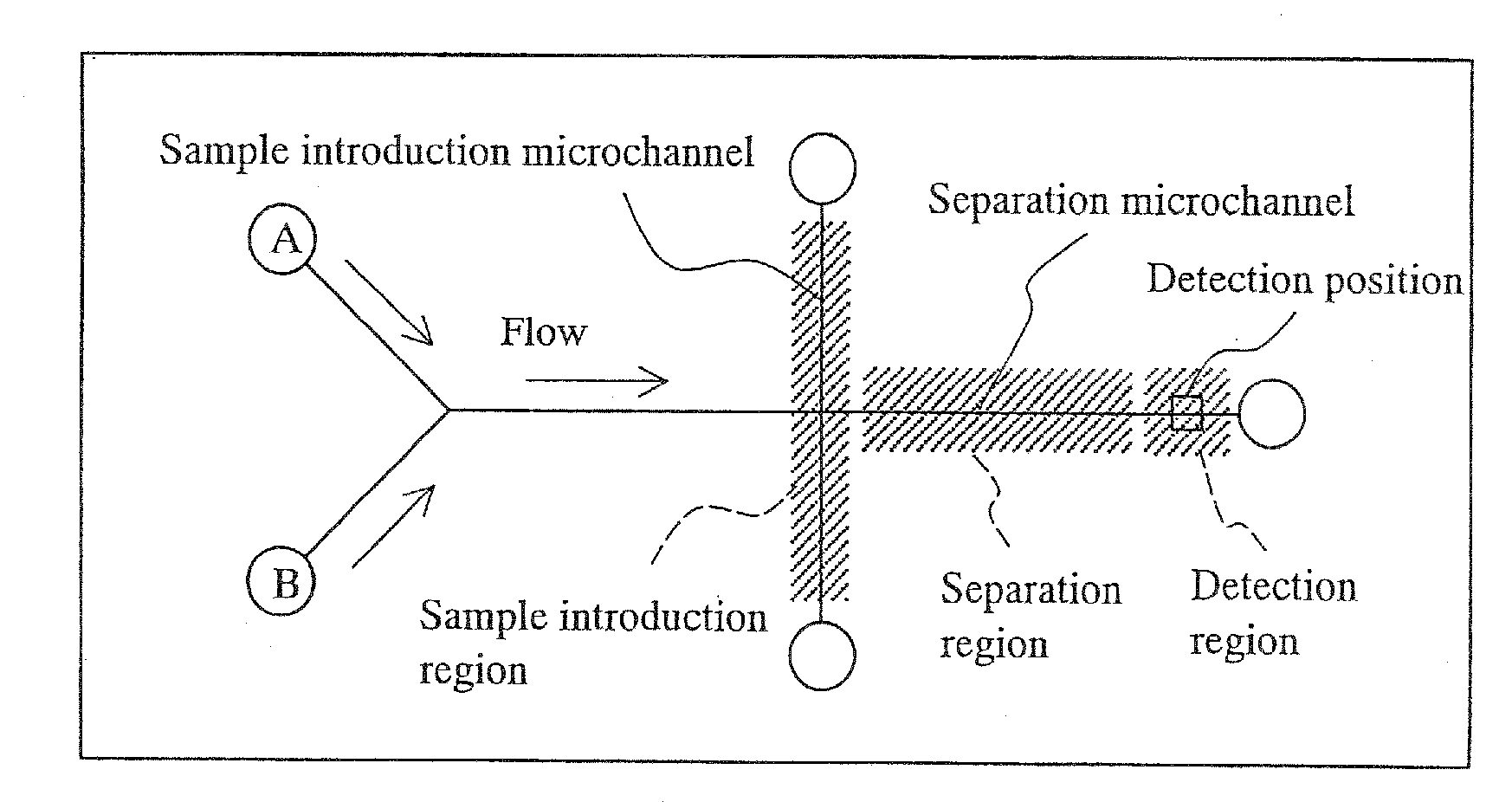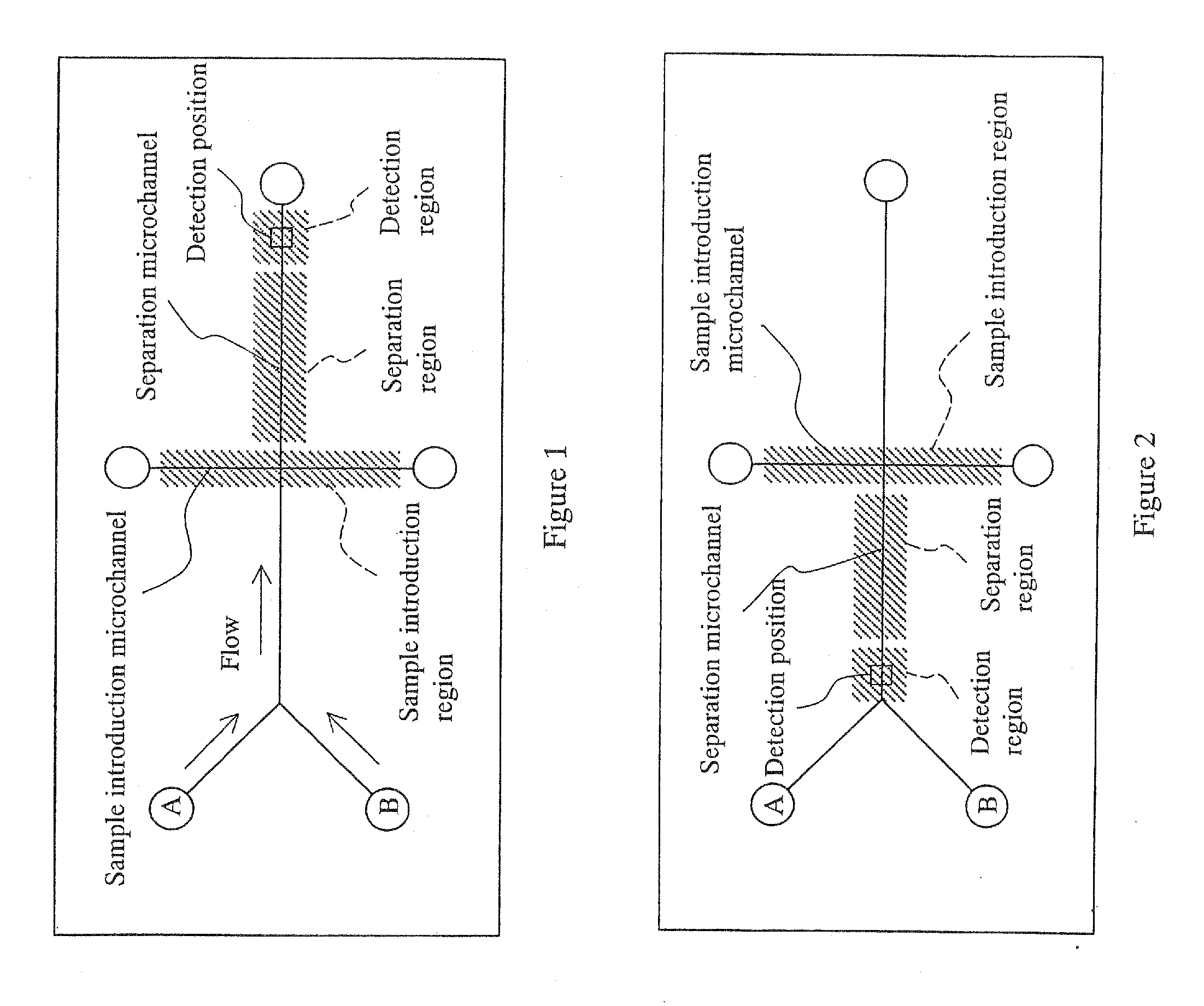Microchip electrophoresis method and device
a microchip and electrophoresis technology, applied in the direction of fluid pressure measurement, liquid/fluent solid measurement, peptide measurement, etc., can solve the problems of temperature control in microchips, high reproducibility and detection efficiency cannot be obtained, and prior technologies do not relate to techniques for separating double-stranded nucleic acids. achieve high reproducibility and detection efficiency
- Summary
- Abstract
- Description
- Claims
- Application Information
AI Technical Summary
Benefits of technology
Problems solved by technology
Method used
Image
Examples
example 1
[0063]A temperature control test was performed using an acrylic resin microchip (8.5 cm×5 cm, thickness 1 mm). K-type thermocouples were used as the temperature sensors and fixed to the center of the microchip top surface. The heaters were of the transparent conductive film type. The temperature controller was of the PID control type. Temperature measurements were taken with K-type thermocouples and recorded on a notebook computer.
[0064]When the preset temperature was raised from 48 to 50° C. in 1 degree increments in the test, the temperature distribution inside the microchip remained within ±2.5° C. of the preset temperature in each case. The same test was also performed with aluminum foil (0.1 mm thick) of the same size as the microchip inserted between the microchip and heaters to further reduce the temperature distribution of the microchip. As a result, the temperature distribution of the microchip was within ±1° C. of the preset temperature at each temperature level.
example 2
[0065]Two kinds of DNA with different nucleotide sequences are separated using a DGGE microchip with the flow shown in FIG. 3.
[0066]PCR products of the V3 regions of 16s rRNA genes obtains from two different kinds of Sphingomonas are used as the DNA samples. In the preparation of the DNA samples, the two different microorganisms are first cultured in liquid medium, and collected by centrifugation. The cells are mixed, and DNA is extracted from the mixture by the benzyl chloride method. This extracted DNA is subjected to PCR using universal primers targeting the V3 region of the 16S rRNA gene (forward: 5′-CGCCCGCCGC GCGCGGCGGG CGGGGCGGGG GCACGGGGGG CCTACGGGAG GCAGCAG-3′ (SEQ ID NO 1); reverse: 5′-ATTACCGCGG CTGCTGG-3′ (SEQ ID NO 2)), and the resulting PCR product is the final DNA sample. The forward primer is provided with a GC clamp.
[0067]A microchip having a microchannel 100 μm wide and 25 μm deep formed by photolithography on Pyrex™ glass (7 cm×3.5 cm) is used in the test. This mi...
example 3
[0070]A system was constructed for independently controlling the temperature of one part of a microchip in order to spatially control the temperatures of the regions for performing the sample introduction process, separation process and detection process. A microchip (8.5 cm×5 cm, thickness 1 mm), copper plate (1 cm×4 cm, thickness 3 mm), Peltier element (8 mm×8 mm), copper plate and heat sink were affixed together in that order, and a thermistor was attached as the heat sensor to the copper plate contacting the microchip. The Peltier element was connected to a fixed voltage power source, and the output was controlled with a temperature controller. The temperature behavior of the copper plate attached to the microchip was measured using a K-type thermocouple as the preset temperature was varied. As a result, the variation in temperature measurements over time was within ±0.6° C. when the preset temperature was 30° C., 40° C., 50° C. and 60° C.
PUM
| Property | Measurement | Unit |
|---|---|---|
| Temperature | aaaaa | aaaaa |
| Temperature | aaaaa | aaaaa |
Abstract
Description
Claims
Application Information
 Login to View More
Login to View More - R&D
- Intellectual Property
- Life Sciences
- Materials
- Tech Scout
- Unparalleled Data Quality
- Higher Quality Content
- 60% Fewer Hallucinations
Browse by: Latest US Patents, China's latest patents, Technical Efficacy Thesaurus, Application Domain, Technology Topic, Popular Technical Reports.
© 2025 PatSnap. All rights reserved.Legal|Privacy policy|Modern Slavery Act Transparency Statement|Sitemap|About US| Contact US: help@patsnap.com



